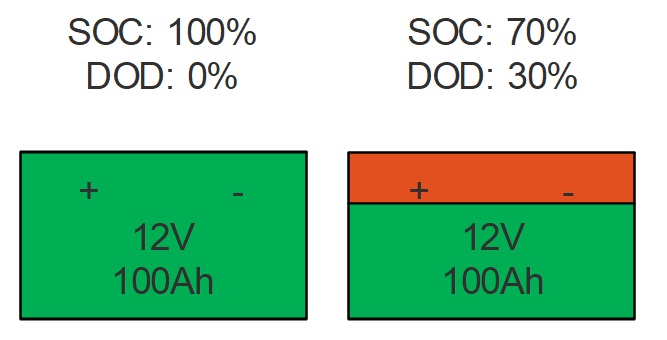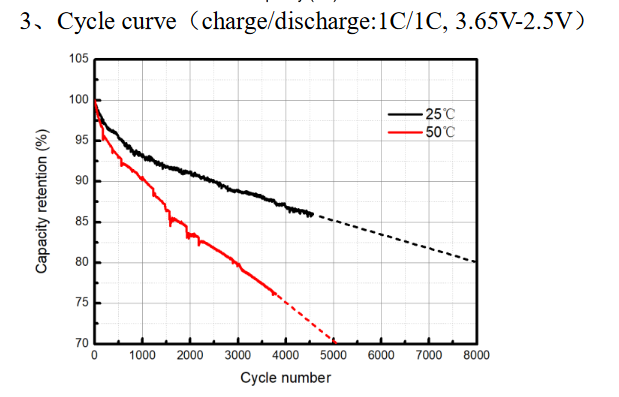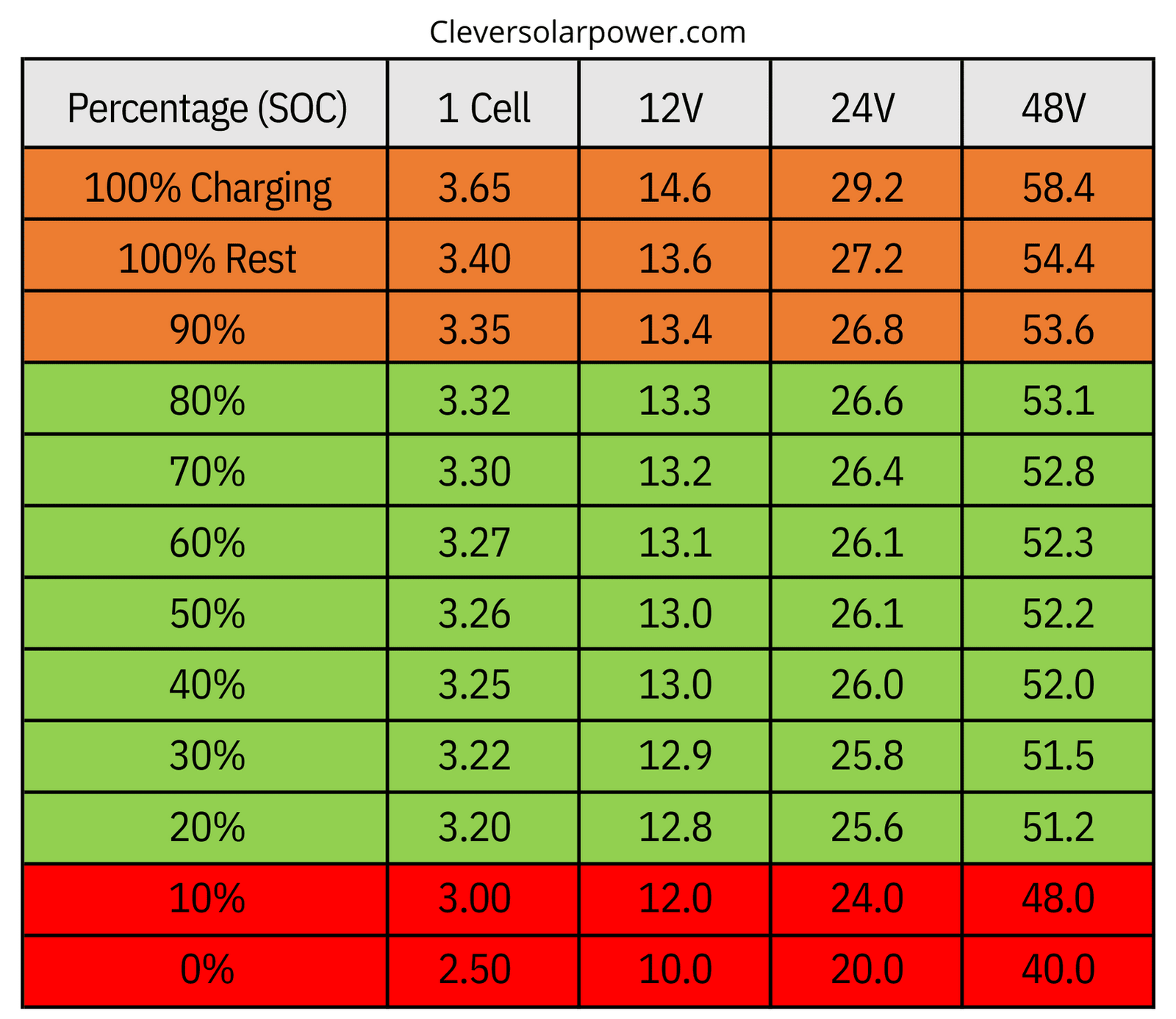I recommend cycling LiFePO4 from 10-90%. That means you will have an 80% depth of discharge. Read to the end of the article to find out how you can do this in your DIY system.
This is what EVE, a major LiFePO4 cell manufacturer recommends:

What is Depth of Discharge?
Depth of Discharge (DoD) refers to the percentage of a battery’s capacity that has been used up compared to its total capacity. It is an essential metric for determining a battery’s remaining energy and plays a significant role in evaluating its lifespan and performance.
Difference Between DoD and SOC

While DoD measures the percentage of used energy, the State of Charge (SOC) represents the remaining energy in a battery.
SOC is the inverse of DoD. For example, if a battery has a DoD of 30%, its SOC would be 70%, meaning the battery still holds 70% of its total capacity.
What is Cycle Life?
Cycle life is the number of charge and discharge cycles a battery can go through before its capacity is reduced to a specific level, usually 80% of its original capacity.
A single cycle consists of charging the battery to its full capacity, discharging it to a certain DoD, and then recharging it. The cycle life of a battery is a crucial factor in determining its overall lifespan.
The standard cycle life of EVE LiFePO4 cells is 7,000 cycles at 25°C or 77°F
If the temperature increases, the cycle life drastically reduces. This becomes 2,500 cycles at 45°C or 113°F.

Therefore it’s always recommended to use your battery at room temperature.
Recommended DoD for LiFePO4 Batteries
LiFePO4 (Lithium Iron Phosphate) batteries typically have a higher allowable DoD than traditional lead-acid batteries.
Most LiFePO4 batteries can safely discharge up to 80% or even 90% of their total capacity without causing significant damage to the battery.
While you can cycle lithium from 0% to 100%, it is generally not recommended. This can make the battery degrade faster.
Always follow the manufacturer’s guidelines for the recommended depth of discharge to optimize your LiFePO4 battery’s performance and longevity.
How to Extend the Lifespan of Your LiFePO4 Battery
To prolong the life of your LiFePO4 battery, consider the following tips:
- Avoid Deep Discharges: Although LiFePO4 batteries have a high allowable DoD, regularly discharging the battery to a lower DoD can further extend its lifespan.
- Use a Battery Management System (BMS): A BMS monitors and balances the cells within the battery, protecting it from overcharging, over-discharging, and overheating.
- Maintain Optimal Temperature: LiFePO4 batteries perform best at room temperature. Avoid exposing the battery to extreme heat or cold, negatively impacting its performance and lifespan.
- Store the Battery Properly: If storing the battery for an extended period, ensure it’s charged to around 50-60% of its capacity and kept in a cool, dry place. Don’t let the battery freeze.
How to charge and discharge your battery from 10% to 90%
You can do it manually by looking at your shunt display and stopping the charge at 90%, which means disconnecting your solar panels. Conversely, you can stop using electricity when the shunt indicates 10%.
However, if you want to automate it, there is another way.
Charging
You need to adjust the voltage levels of your charge controller. If you look at the following image, you can see the voltage level at the state of charge from a lithium battery.
You need to go into the charge controller’s settings and set the charging voltage manually to 90%. This will be 13.4V for a 12V battery.

Discharging
The same goes for discharging. We must apply voltage changes to the BMS or the low voltage disconnect.
I recommend changing the settings of the BMS otherwise you need to buy an additional low voltage disconnect.
You need to set 12V in the BMS as the low voltage cutoff.
Balancing your cells
Over time, the cell voltages will drift away from each other. This is called unbalanced. It happens naturally because not each cell has the same internal resistance. Overtime this can add up.
Cell balancing only happens when the battery is 100%. So when your battery is 90%, check if there is a large voltage difference between the cells and charge up to 100% to balance the cells.
Conclusion
There you have it. Now you should know the perfect depth of discharge for a lithium battery along with the reasons why and methods how you can do it.
Recommendation: cycle your LiFePO4 battery from 10% to 90% to increase battery lifespan.
Read more: Lead acid vs lithium batteries cost analysis
[custom-related-posts title=”Related Posts” none_text=”None found” order_by=”title” order=”ASC”]
I’m an off-grid enthusiast. I created this website to give clear and straight-to-the-point advice about solar power. I’m also the author of the book ‘Off-grid solar power simplified‘. Read more about me on my about page, check out my Youtube channel, or send me a message.
it was simple and easy understandable detail given in your site,
i was planing to make 12v, 12ah battery and solar charged exterior multi color light with Bluetooth controller which will through mobile app
i may need to more about solar panel and its out put for charging battery
thank you
Checkout my article about PWM vs MPPT charge controller.
There’s a complication: most BMSes need the battery to reach closer to 100% SoC or approximately 14.4V to balance the internal cells. In many cases, following your charging algorithm would not allow cell balancing to occur.
That is true. You have to keep the voltage differential in mind and check it regularly. If you see its different, close to being full, you need to charge to 100%. I will add your comment into the post. Thanks.